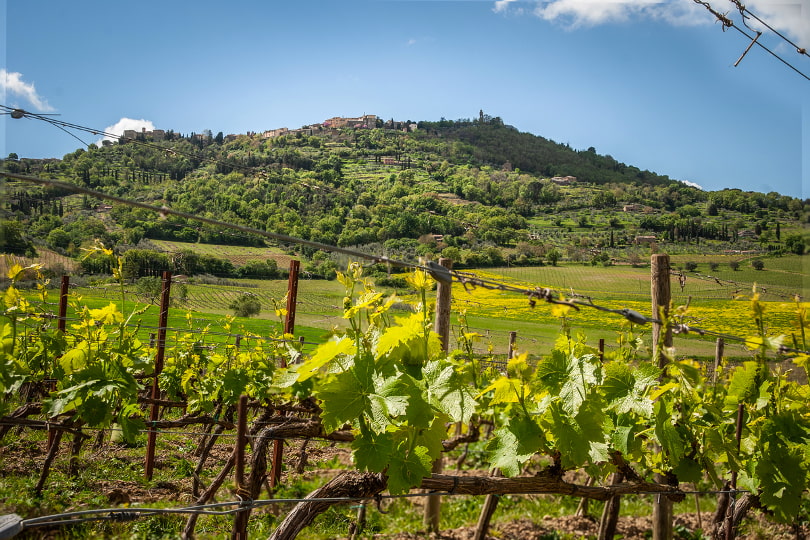
A guide to Rosso di Montalcino

Rosso di Montalcino continues to divide opinion. It has been described as Brunello di Montalcino’s younger cousin, composed of grapes from lesser vineyard sites or young vines. Others regard the Rosso di Montalcino DOC as a reliable source of straightforward wines, destined for the kitchen rack.
But it’s neither. Rosso di Montalcino is Tuscany’s best-kept secret. The red wines are made in the Montalcino region, an established favourite of sybarites and well-travelled connoisseurs. You’ll find it in Southern Tuscany, south of the city of Siena. The vineyards flank the hilltop town of Montalcino, which was once the poorest village in rural Tuscany.
For decades, Sangiovese grown in this part of Italy was confined to local palates. There was no money available for international marketing or exports. However, an explosion of interest in the 1980s lured in global finance and investors from neighbouring regions. Today the Brunello di Montalcino DOCG is regarded as the archrival of Barolo and Barbaresco, competing for the title of Italy’s finest red wine.
Click on a link to jump to that section:
Regional history and changes
Historically, Sangiovese was aged for exceptionally long periods in this corner of Tuscany. The formula involved harvesting super-ripe grapes of Sangiovese and then leaving the wine for years in Slavonian oak casks. The result was a wine of immense concentration and power, and yet often frustratingly closed in its (relative) youth.
Fortunately, Montalcino’s winegrowers are open to change. Local wine laws have been adapted to modern tastes; the most significant evolution was changing the rules on oak ageing. The once obligatory four years in wood was changed to two (Brunellos are released after four years), to avoid subjugating Sangiovese’s diverse fruit profile. And more significantly, Brunello di Montalcino DOCG was the first major appellation to create a ‘subsidiary’ DOC designation: Rosso di Montalcino.
The DOC was introduced to consumers in 1984. Its purpose was twofold: Brunello’s leading producers wished to keep their best quality fruit for the top wines, maintaining impeccable standards in the zone. Secondly, and more importantly, the region wanted to market a younger, more approachable style of Montalcino wine to a different audience.
Brunello vs Rosso di Montalcino
The key differences between Brunello and Rosso di Montalcino wines are often stylistic in nature. The paradigm of regarding Rosso as automatically inferior is just plain wrong. Rosso di Montalcino is made with great care and attention in the winery, emulating the craftsmanship of Brunello di Montalcino. Both styles must be made from 100% Sangiovese grapes. Yet the Rosso versions are designed to be enjoyed at a younger age, with a different flavour profile to long-aged Brunello wines. After enjoying a minimum ageing period of only six months in oak (one year total before release), Rosso di Montalcino is rarely austere or harshly tannic.
This is to our advantage. The world is full of marvellous, costly wines which are unapproachable at a young age. Rosso di Montalcino is both attractively priced and usually a delight to drink. Leading examples marry the best elements of Brunello (concentration and aromatic complexity) with a freshness and delicacy that is addictive. The fruit profile is typically red cherry and wild-berries, dancing over notes of vanilla, spice and cedarwood, courtesy of the oak ageing. There is nothing dreary about Rosso di Montalcino. Trust us.
The only question mark over the region’s future concerns the inclusion of French grape varieties. A few major producers have petitioned the authorities to allow ‘international varieties’ into the blends, yet the motion was defeated. But they’ll undoubtedly try again. Whether a little Cabernet Sauvignon would contribute anything is a subject for endless debate. In the meantime, Rosso di Montalcino remains as delicious as ever.
The best elements of Brunello and Rosso di Montalcino
|
Flavour profile |
Ageing requirements |
Average RRP |
|
|---|---|---|---|
|
One of the prestige labels of Tuscany; long-aged, full-bodied and powerfully structured wines. In the best vintages, it may take some years after release for the fruit and complexity to fully emerge. Critics talk of leather and truffle notes with extended bottle age. |
Under the Brunello di Montalcino DOCG regulations, the wines must be aged for a minimum period of four years before release (five for a Riserva version). The wines will spend two years in oak barrels, with the remainder usually spent in bottles. Always 100% Sangiovese wines. |
Expensive—anything upwards from £45. Collectors will pay in excess of £1000 for rare vintages found at auction. |
|
|
Marketed at a younger age, Rosso di Montalcino is typically approachable upon release. Usually medium-bodied, the wine should have an attractive, fruit-forward profile of red and black cherry, raspberry and plum. Lighter than Brunello, Rossi di Montalcino rarely has a powerful tannic structure. |
The Rosso di Montalcino DOC rules state that the wines will be aged for a minimum period of six months in barrel and bottle before release. A fresher, fruitier style of Sangiovese, designed for earlier drinking. Always composed of 100% Sangiovese. |
Generally affordable at under £50. Many great wines are available at average retail prices of £25. The quality/price ratio is unbeatable. It is arguably Tuscany’s best value red wine. |




